Residual ridge resorption refers to the wearing away of the alveolar ridge following teeth extractions, which complicates the border moulding procedure [3]. Long-span edentulism and the use of ill-fitting dentures can lead to severe resorption of edentulous ridges [3]. Extreme resorption of the ridge, whether in the maxilla or mandible, results in a reduced denture-bearing area that affects retention, stability, and support for the complete denture [4]. Consequently, there is a need to select an appropriate border moulding technique to ensure adequate retention of dentures in resorbed ridges.
In 1971, Jankelson B et al., advocated for recording border moulding using TENS as a possible alternative to conventional border moulding techniques [5]. The conventional method of border moulding is operator-dependent, whereas the tissue function using TENS is patient-dependent [5]. Conventional TENS operates through the gate control theory [6]. The term Ultra-low Frequency (ULF) is used when a frequency of <4 Hz is employed for stimulation [7]. Ultra-low Frequency TENS (ULF-TENS) is thought to act on the muscular component via dromic and antidromic mechanisms, causing contraction of the 7th and 5th pairs of cranial nerves [8]. These cranial nerves supply the masticatory muscles in the face, which play an important role in the border moulding procedure. TENS induces a small electric current that causes controlled twitching of the facial muscles [2].
Meyerowitz WJ reported that 32% of 190 completely edentulous patients experienced pain upon palpation of the masticatory muscles [9]. Therefore, TENS has the added benefit of deconditioning the muscles and relieving masticatory muscle pain. TENS uses four surface electrodes [8], which are placed on the patient’s face with self-adhesive tapes to deliver current at variable amplitudes and frequencies [8].
Three border moulding techniques were employed for each patient: ULF-TENS was used to record a single-step border moulding using polyvinyl siloxane elastomeric border moulding material [18,19]; a final impression was made using light body polyvinyl siloxane elastomeric material. The second technique involved single-step border moulding without ULF-TENS, also using polyvinyl siloxane elastomeric material, followed by a final impression using light body polyvinyl siloxane elastomeric material. The third technique utilised soft-tissue liners for functional border moulding.
Materials and Methods
This non randomised clinical study was conducted in the Department of Prosthodontics and Crown and Bridge at KVG Dental College and Hospital in Sullia, Karnataka, India, from January 2022 to December 2023. The study was approved by the Institutional Ethical Committee (IECKVGDCH/26/2022-23), and informed consent was obtained from all participants. A simple random sampling based on mean difference of a previous study was done.
Inclusion and Exclusion criteria: Patients with a completely edentulous maxilla and mandible aged between 40-70 years were included in the study. Exclusion criteria included patients with severe undercuts, bony exostoses and tori, an extremely high palatal vault, poor neuromuscular control, epilepsy, or cardiac pacemakers.
Study Procedure
For each patient, a primary impression of the upper arch was made using irreversible hydrocolloid impression material to obtain the primary cast [9]. The cast was properly outlined for the fabrication of custom impression trays using cold cure acrylic resin (DPI cold cure, The Bombay Bumrah Trading Corporation Ltd., Mumbai, Maharashtra, India).
Three identical trays with full spacers (Sharry spacer) were fabricated, with two trays measuring 2-3 mm and one tray measuring 1.5-2 mm, each 2 to 3 mm short of the tissue reflection line. Two trays had handles, while one was without a handle. Three impressions were taken from each patient.
Group-A: Total 10 border mouldings were performed using TENS and soft putty polyvinylsiloxane border moulding material, followed by a final impression made with light body polyvinylsiloxane impression material.
Group-B: Total 10 border mouldings were performed using soft putty polyvinylsiloxane border moulding material, with the final impression made using light body polyvinylsiloxane impression material.
Group-C: Total 10 functional border mouldings were performed, and the final impression was made using a tissue conditioner. The patients were recalled after 24 hours for retrieval.
The treatment procedure was thoroughly explained to the patients, and only those who agreed to participate in the clinical trial and signed the informed consent form were included in the study. A break of 30 minutes was provided to the patients before each border moulding session.
Patients were given 20 minutes of TENS (TENS Medi Gray MH8000, Keelung City, Taiwan) adjusted to 4/sec and a frequency of 4 Hz for muscle deconditioning. After the muscle deconditioning, a custom tray, which had a full spacer of 2-3 mm thickness, was lined with polyvinylsiloxane border moulding material (Photosil, dental products of India, Bombay Bumrah Trading Cooperation Ltd., Mumbai). The intensity of the TENS was increased to 7/sec until twitching of the facial muscles was observed, and a single-step border moulding was carried out. The borders were moulded by the twitching of the muscles without any manual movement by the operator. After a 40-minute rest [17], final impressions were made using light body addition silicone impression material (Reprosil, Dentsply, base paste and catalyst paste, hydrophilic vinyl polysiloxane impression material, Mudka Industrial Area, Main Rohtak Road, Delhi).
Using the second tray, which had a full spacer of 2-3 mm thickness border moulding was completed using the single-step border moulding method. This involved soft putty polyvinyl siloxane and light-bodied addition silicone impression material to create the final impression. The third tray, which had a full spacer of 1.5-2 mm thickness, had tissue conditioner (GC Relinetm extra soft, GC Company, Tokyo) applied to it. This tray was then inserted into the patient’s mouth and retrieved after 24 hours to collect the impression [20].
Three prefabricated stainless steel loops (0.9 mm) were attached to all three custom trays in the anterior region using self-curing acrylic resin. A digital force gauge [Table/Fig-1] was engaged onto the loop of the custom tray with a secondary impression, and force was applied by pulling it downward while being held in the palm of the operator. The force was directed perpendicularly to the occlusal plane to evaluate retention [Table/Fig-2]. Three readings were recorded for each impression, and the collected data were tabulated and statistically analysed.
Lutron force gauge (20 kg).
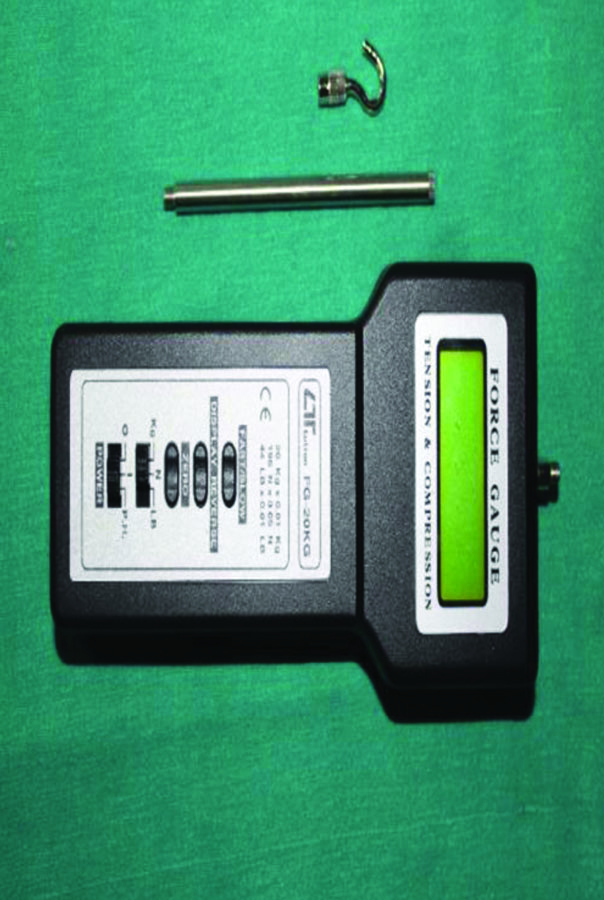
Recording the force required to dislodge the denture bases using digital force gauge.
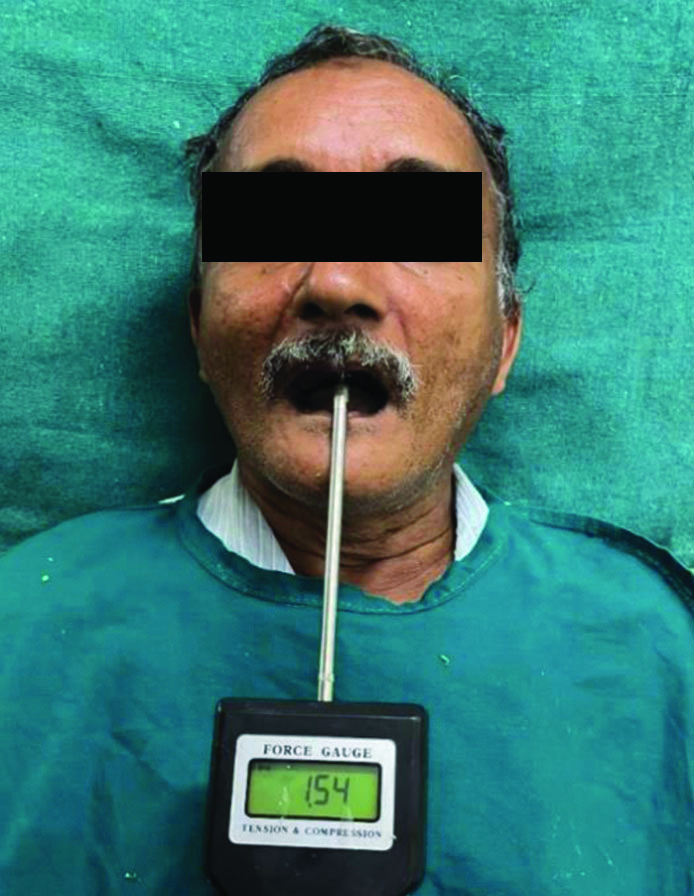
Beading and boxing were performed, and master casts were obtained [Table/Fig-3]. The arrangement of teeth was completed, and a try-in of each denture was conducted to check for proper fit and speech. Each patient received three heat-cured permanent complete upper dentures and one complete lower denture constructed from three maxillary master casts obtained from three groups in the study [Table/Fig-4]. Subsequently, three prefabricated stainless steel loops were attached to all three heat-cured dentures using self-curing acrylic resin in the anterior palatal region, approximately corresponding to a line joining the distal surfaces of the cuspids and midline (geometric center).
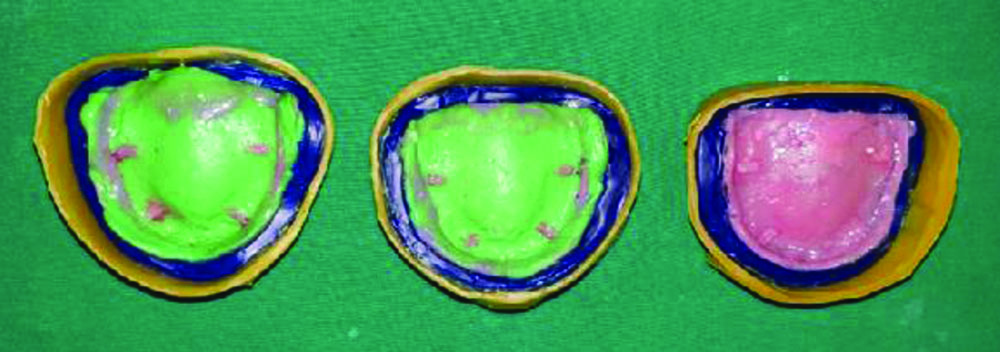
Group-coded heat cured dentures.

The patient was made to stand upright with the maxilla parallel to the floor, and the digital force gauge was engaged onto the loop of the final dentures. Force was applied by pulling it downward while being held in the palm of the operator. The force was directed perpendicularly to the occlusal plane to record retention. The assessment of retention was carried out after the secondary impression and after the fabrication of the dentures to ensure that the values did not vary due to any acrylisation errors. Readings were recorded, and the collected data were tabulated and statistically analysed.
A comprehensive analysis of the patients’ responses was recorded using a questionnaire after the retention was measured using the force gauge, following the secondary impression and after the delivery of the final dentures. The questionnaire was self-prepared and contained a total of seven questions for each technique. It was sent to experts in the field for validation. After validation, two questions were removed, resulting in five questions for each technique being used. The reliability was noted to be 0.82.
Statistical Analysis
Statistical analysis was performed using Statistical Packages of Social Sciences (SPSS) version 21.0. The significance level was set at ≤0.05. For the comparison of the data, ANOVA statistical technique was employed and randomised control trials were conducted with SD=Standard Deviation- 2.47, Z1-α/2=1.96 at 95% confidence interval, zβ=0.84 at 80% power, d=mean difference=3.30.
Results
In the present study, the retention provided by single-step border moulding with TENS (Group-1), single-step border moulding without TENS (Group-2), and functional Border Moulding (BM) with tissue conditioner (Group-3) was compared among 10 subjects. The patients selected for the study had a mean age of 59.0±4.67 years, with four females and six males, all requiring complete dentures. There was a significant difference between the mean retentive values (kgf) of the three groups of final impressions (p<0.001), as illustrated in [Table/Fig-5]. On pair-wise comparison between the different groups, significantly higher retention was observed in the final impressions made using TENS and putty compared to Tissue Conditioners (TC) (p=0.001, 0.008, respectively) [Table/Fig-6].
Comparison of retentive force among the studied groups (in kg) of final impressions.
| Groups | Mean±Std. Deviation | 95% CI for mean | Minimum | Maximum | p-value |
|---|
| Lower bound | Upper bound |
|---|
| BM TENS | 2.58±0.56 | 2.18 | 2.99 | 1.80 | 3.70 | <0.001 |
| BM putty | 2.30±0.53 | 1.92 | 2.69 | 1.45 | 3.04 |
| BM TC | 1.26±0.94 | 0.59 | 1.94 | 0.22 | 2.70 |
Test: ANOVA test
Group-wise multiple comparison of retentive force among the studied groups using Post-hoc Tukey’s test in final impression.
| (I) Groups | (J) Groups | Mean difference (I-J) | p-value |
|---|
| BM TENS | BM putty | 0.27900 | 0.656 |
| BM TC | 1.31900* | 0.001 |
| BM putty | BM TENS | -0.27900 | 0.656 |
| BM TC | 1.04000* | 0.008 |
| BM TC | BM putty | -1.04000* | 0.008 |
| BM TENS | -1.31900* | 0.001 |
*The mean difference is significant at the 0.05 level
Similarly, a significant difference was observed between the mean retentive values (kgf) of the final dentures of the three groups (p<0.001). The final denture made using TENS and border moulding showing the highest retention [Table/Fig-7]. On pair-wise comparison between the different groups, significantly higher retention was observed in the final dentures made using TENS and putty compared to tissue conditioners (p=0.002, 0.008, respectively) [Table/Fig-8].
Comparison of retentive force among the studied groups (in kg) of dentures.
| Groups | Mean±Std. Deviation | 95% CI for mean | Minimum | Maximum | p-value |
|---|
| Lower bound | Upper bound |
|---|
| Final TENS | 2.49±0.99 | 1.78 | 3.20 | 1.09 | 4.80 | <0.001 |
| Final putty | 2.33±0.45 | 2.00 | 2.66 | 1.50 | 3.20 |
| Final TC | 1.23±0.69 | 0.74 | 1.73 | 0.45 | 2.10 |
Test: ANOVA test
Group-wise multiple comparison of retentive force among the studied groups using Post-hoc Tukey’s test in dentures.
| (I) Groups | (J) Groups | Mean Difference (I-J) | p-value |
|---|
| Final TENS | Final putty | 0.16000 | 0.882 |
| Final TC | 1.25800* | 0.002 |
| Final putty | Final TENS | -0.16000 | 0.882 |
| Final TC | 1.09800* | 0.008 |
| Final TC | Final putty | -1.09800* | 0.008 |
| Final TENS | -1.25800* | 0.002 |
*The mean difference is significant at the 0.05 level
A comprehensive analysis of the patients’ responses after the denture delivery using the three different techniques of border moulding- namely Group-A, Group-B, and Group-C-was conducted. Responses regarding comfort, fit of the denture, retention of the denture while speaking, chewing ability, and overall experience were assessed. It was inferred that comfort was better in Group-B. Both Groups A and B demonstrated a good fit of the denture. The retention of the denture, chewing ability, and overall experience were higher in both Groups A and B. [Table/Fig-9,10,11 and 12] show a comparison of patient’s responses toward each technique recorded during secondary impression and final denture insertion.
Comparison of retentive force among the studied groups (in kg).
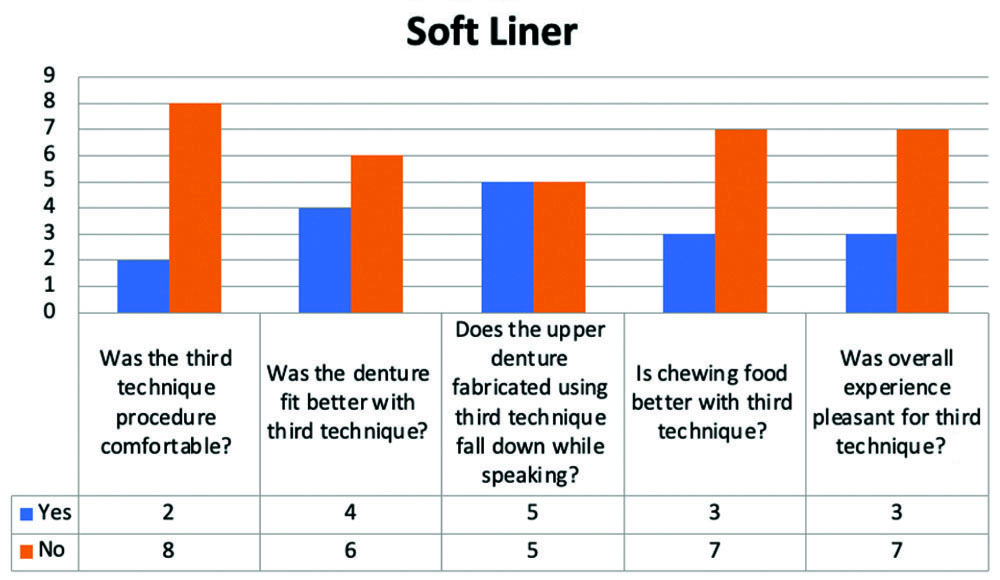
Comparison of response of patients to dentures given using soft liner.
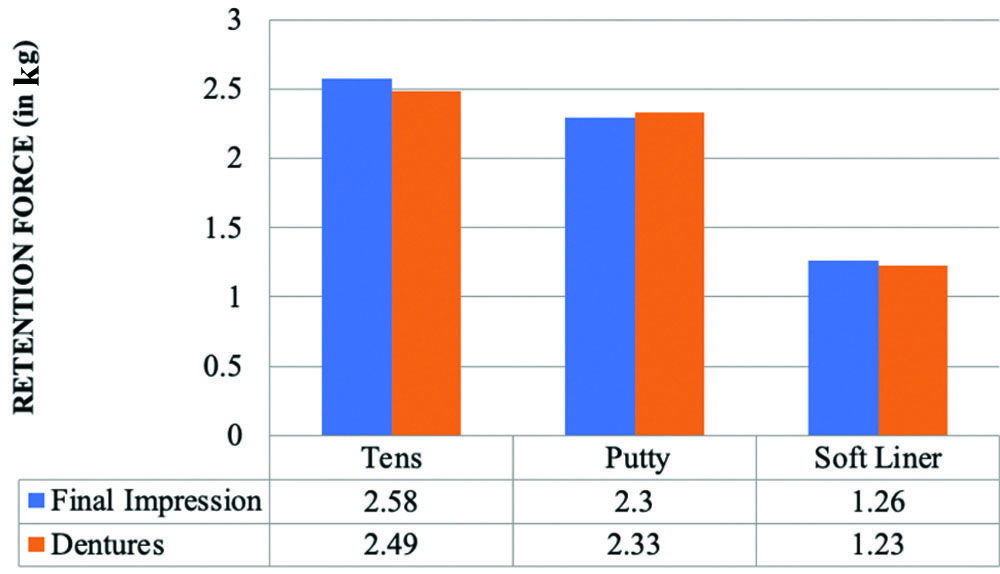
Comparison of response of patients to dentures given using TENS.
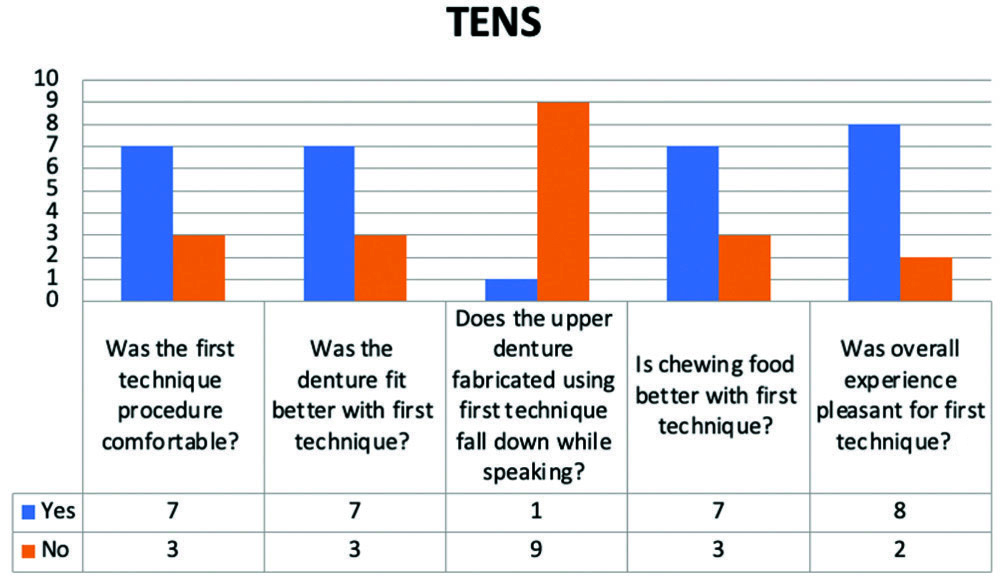
Comparison of response of patients to dentures given using putty.
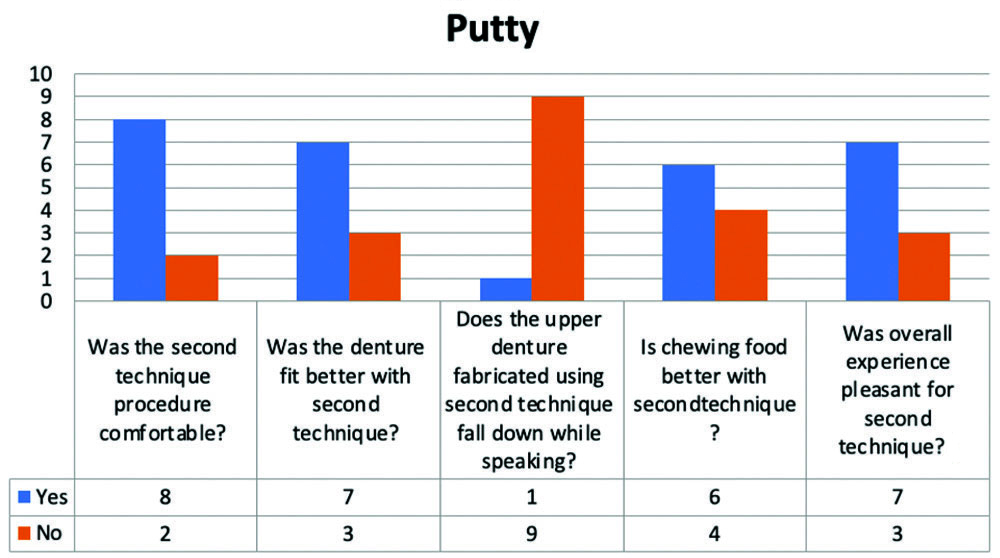
Discussion
In present study, it was found that border moulding with TENS using polyvinyl siloxane putty and light body for the secondary impression provided higher retention compared to functional border moulding using a tissue conditioner.
The primary impression should achieve the goals of retention, stability, and functional support, all of which play a vital role in maintaining resorbed ridges [10]. Soft-tissue displacements can range from 2 to 2.5 mm while making an impression [10]. The primary impression made in present study used alginate, which does not compress the underlying mucosa [10]. The use of minimal and selective pressure impression techniques should be employed [11]. Additionally, irreversible hydrocolloid impressions provide refined and detailed surface details [11].
In the present study, light-body addition silicone was chosen for the final impression because it is biocompatible, has good flow behaviour, offers sufficient working time, and provides dimensional accuracy and stability, along with a pleasant colour and odour [4]. The advantage of this technique is that non stress-bearing areas are recorded with minimal pressure, while selective pressure is applied to specific locations that can withstand occlusal forces, as proposed by Boucher [4].
A tissue conditioner was also used for border moulding in present study to compare retention. Jankelson B and Radke JC found that manipulating the cheeks and lips during impression procedures can lead to underextensions of the boundaries when the muscles return to their resting lengths [21]. The tissue conditioner was used to record functional border moulding. Custom trays lined with tissue conditioner were left in patients’ mouths for 24 hours to adequately mould the borders [20]. Ideally, physiologic and functional boundaries are recorded with materials that can flow continuously over an extended period. Recent studies [20,22] have shown that it can be left for a period of 24 hours. However, only tissue conditioner possesses this ability among the available materials [20]. Tissue conditioner is a material that flows over time and provides an accurate representation of the border morphology of the tissues, as demonstrated by Abdel Hakim AM et al., [23].
The term ULF-TENS refers to the frequency of current being less than 4 Hz [7]. Compared to traditional TENS, ULF-TENS offers several advantages, including being less invasive, causing minimal side effects, being less technique-sensitive (patients typically self-administer after receiving the necessary training), and being relatively easy to use [5]. There are few studies in which ULF-TENS has been used to record the intaglio surface of denture for better adaptation [13-15].
The frequency of the current delivery rate should be adjusted to 2-4 Hz, and the amplitude should be increased from 0 to 4 based on the patients’ tolerance levels and subjective symptoms. Muscle twitching typically begins at 10-12 minutes, and TENS can be applied for a total of 40 minutes [17]. There is no need to perform any manual or functional movements; instead, the surrounding musculature will twitch, allowing the recording material, polyvinylsiloxane, to conform to the sulcus [15]. Additionally, silicone material was loaded into a syringe with the needle hub removed to ensure uniform distribution of the material along the borders [15].
Three aspects contribute to the success of complete dentures: retention, stability, and support [12]. Retention is defined as the inherent quality of the dental prosthesis that resists the forces of dislodgement along the path of placement [24]. As recommended by Burns DR et al., for a more objective assessment, the digital force gauge (Leutron digital force gauge- 20 kg) was the tool of choice for evaluating retention [25]. Placing the loop more anteriorly ensures a force perpendicular to the denture base, rather than the oblique stresses produced when the loop is attached at the geometrical center. This was done to ensure that the definition and guidelines for retention were followed [25-28].
The differences in retention between secondary impressions and dentures obtained through border moulding using putty addition silicone and secondary impressions made using light body silicone, with and without the use of TENS, were statistically not significant. Hence, it can be inferred that TENS may be used only when there is an underlying TMJ disorder and when the usual method of recording border moulding with putty impression material becomes difficult. This is in line with the findings of Yarapatineni R et al., Gupta R et al., Ammar MM et al., and Rizk FN et al., who supported the use of putty consistency addition silicone as a border moulding impression material and light body addition silicone as a secondary impression material [4,18,29,30].
Contrary to the results of present study, Qanungo A et al., investigated and concluded that putty polyvinyl siloxane was less retentive compared to the incremental technique using green stick impression material for border moulding [25]. Chaware SH and Fernandes F conducted a study on flat mandibular ridge cases and discovered that the tissue conditioner caused the least tissue stress to record the border seal area, as it has unidirectional flow characteristics, which led to increased retention and stability of the denture [31,32]. Patel JR et al., concluded in their study that the tissue conditioner was a superior border moulding material compared to pattern resin [21]. Similar studies from the literature have been tabulated in [Table/Fig-13] [14-16,18-20,22,25,26,28,33-35].
Studies comparing various border moulding materials and techniques for denture retention [14-16,18-20,22,25,26,28,33-35].
| S. No. | Author’s name and year | Place of study | Number of subjects | Materials compared | Parameters assessed | Conclusion |
|---|
| 1. | DSouza RD and Verma S, 2022 [19] | Doha, Qatar | 100 | Green stick impression Polysulphide elastomer Poly-ether Polysiloxane impression material
| Retention of dentures | Polysiloxane is a superior material for border moulding material |
| 2. | Zarir R et al., 2022 [20] | India | 20 | Low fusing compound Putty addition silicone Pattern resin Tissue conditioner
| Morphology of the denture borders | Tissue conditioner was the best material that could be used for border moulding followed by pattern resin and low fusing compound |
| 3. | Garg A et al., 2020 [33] | India | 15 | Green stick Putty addition silicone
| Retention of denture bases | Two step impression technique is more retentive as compared to one step impression technique |
| 4. | Rajamani VK et al., 2021 [14] | India | Case report | Low fusing green stick-border moulding Polyvinylsiloxane- secondary impression material TENS
| Nil | Case report describes recording of border mouldings and cameo surface using Ultra low frequency-TENS (ULF-TENS) in a complete edentulous patient, resulting in enhanced adaptation of dentures |
| 5. | Gowda EM et al., 2021 [16] | India | Case report | Polyvinylsiloxane elastomeric impression material ULF-TENS
| Nil | ULF-TENS was used as an aid in cameo surface recording and customised magnet retained cheek plumber for rehabilitation with complete denture prosthesis |
| 6. | Jassim TK et al., 2020 [26] | Iraq | 10 | Addition vinyl silicone- single step border moulding Green stick compound
| Retention of dentures | Addition vinyl silicone used for single-step border moulding provided superior retention |
| 7. | Pridana S et al., 2019 [28] | Indonesia | 10 | The heavy body polyvinylsiloxane (dispensing gun)- Polyvinylsiloxane putty (mixed manual)
| 1. Retention of final impression2. Morphologic detail of peripheral tissue | Putty polyvinylsiloxane with functional technique can be recommended for border moulding procedure |
| 8. | Pachar RB et al., 2018 [35] | India | 10 | Green stick impression compound Putty consistency addition silicone Polyether impression material
| Retention of complete denture | Dentures made using polyether final impression material showed the highest mean values of complete denture retention followed by putty rubber base border moulding with light body final wash |
| 9. | Qanungo A et al., 2016 [25] | India | | Green stick impression compound. (sectional) Putty consistency addition silicone. (single step)
| Retention of heat cure trial denture bases | Sectional border moulding technique proved to be more retentive as compared to single-step border moulding although clinically the retention appeared comparable |
| 10. | Gupta R et al., 2015 [18] | India | 20 | Green stick with incremental technique Heavy bodied polyvinylsiloxane with simultaneous technique
| Retention of dentures | Border moulding with heavy bodied polyvinyl siloxane using simultaneous technique provided better retention as compared to border moulding with modelling compound using incremental technique |
| 11. | Kheur M et al., 2015 [34] | India | 10 | Low fusing Impression Compound Type I Heavy bodied Elastomeric Material: Polyvinyl Siloxane Modified Zinc Oxide Eugenol Impression Paste
| Tissue contact Bond to the tray Tissue displacement Overall peripheral seal
| One step border moulding is a viable and advantageous alternative to conventional border moulding (sectional border moulding) as it results in reduction of chairside time, less discomfort for the patient and less efforts for the dentist |
| 12. | Bulbule NS et al., 2013 [15] | India | Case report | Putty consistency addition silicon TENS
| Nil | Novel, precise and accurate technique of performing border mouldings using TENS |
| 13. | Patel JR et al., 2010 [22] | India | 30 | Tissue conditioner Low fusing impression compound Putty addition silicon Pattern resin
| Area of sulcus using stereomicroscope | Border area recorded using pattern resin is closest in dimension to that obtained using tissue conditioner |
| 14. | Present study | India | 30 | Addition silicon putty with TENS Addition silicon putty without TENS Tissue conditioner
| Retention of secondary impression and dentures using digital force gauge | Border moulding with TENS using polyvinyl siloxane putty and light body secondary impression provided the higher retention when compared to functional border moulding using tissue conditioner |
Limitation(s)
There are a few limitations in the present study. Firstly, in the case of manual border moulding using putty-consistency addition silicone, this method is effective for moulding the borders. However, when using TENS, medium-body consistency addition silicone would have been more beneficial due to its superior flow characteristics. This is important because muscular twitching can occur during border moulding with TENS, and the flowability of the medium-body material would have better adapted to the contours of the borders. Secondly, although border moulding using TENS and putty yielded comparable retention values, TENS therapy is a time-consuming procedure and may be particularly beneficial for patients with Temporomandibular Joint (TMJ) disorders.
Conclusion(s)
In present study, single-step border moulding with TENS therapy using putty-consistency polyvinylsiloxane for border moulding and light-body polyvinylsiloxane impression material for the secondary impression provided the highest retention of both the final impression and the denture when compared to the other groups. The retention was comparable to that of border moulding done with polyvinylsiloxane impression material and light-body addition silicone for the secondary impression, without the application of TENS, and was significantly higher compared to border moulding done using a tissue conditioner. However, comfort was reported to be better without the use of TENS. Thus, it can be concluded that the use of TENS for border moulding can be an alternative method for recording resorbed ridges in cases where there is an underlying TMJ disorder and where the usual method of recording border moulding with putty impression material becomes difficult. Long-term studies are required to evaluate the effects of TENS on the stability, fit, and comfort of dentures, along with comparisons to the different materials available today.
Test: ANOVA test*The mean difference is significant at the 0.05 levelTest: ANOVA test*The mean difference is significant at the 0.05 level